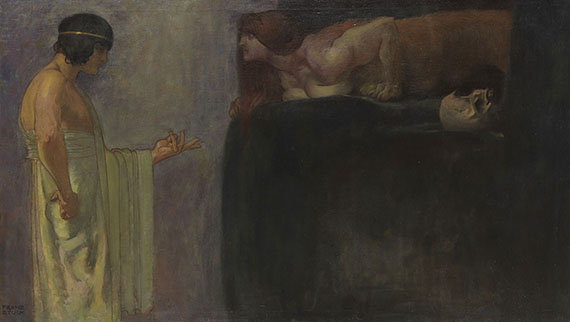Dictionary


French Symbolism
The origins of Symbolism can be found in France. The movement was launched by Jean Moréas in 1886, its actual birth, however has to be determined at an earlier point. The first paintings that deserve to be labeled as symbolist, were made as early as in the middle of the 19th century, even though it took until around 1880-90 that the movement reached its heyday. Symbolist art in France was in close connection with the literary movement of the same name and has to be regarded as a reaction to empirical Naturalism, which also originated in France. The works of the symbolists were united by a hope for a potential of spiritual modernization, even within France artists chose various means of expression. The bible and mythology supplied them with motifs, but also literature. However, the choice of subjects is quite different from those of the traditional genre of history painting, as they were dealing with mystic and occult ideas that often gave their art a transcendental and surreal notion. In this context clear contact points with Romanticism can be observed.
Gustave Moreau (1826-98), student of the romanticist Théodore Chassériau, was one of the most important French symbolists, he even exaggerated his teacher's exotic orientation. By his hands, biblical and mythological subjects were turned to mystic visions that were difficult to comprehend. The female body's sensuality played an important role in his art and must be seen in close connection with the popular topic of the "femme fatale", whereas the seductive woman has to be understood as a threat for the man. His compositions are characterized by a very elaborate treatment of the surface and a suggestive usage of colors.
Odilon Redon (1840-1916) is another main representative of early Symbolism, he also had a very individual style. Redon developed a fantastic and visionary world of images, that was partly nurtured by literary works of Edgar Allan Poe, Gustave Flaubert and Stéphane Mallarmé. His monstrous creatures were modeled after figures in the works of Hieronymus Bosch, Francisco de Goya and Pieter Brueghel The Elder and in return were examples for Alfred Kubin's visions.
Another precursor of French Symbolism worthwhile mentioning is Pierre Puvis de Chavannes. His simplification of forms and his classicist figures made for relevant innovations that were taken on by the group "Nabis". His arcadian illustrations were suitable objects of projection for the symbolist's desire for spirituality.
Besides those artists mentioned, the members of the "Salon de la Rose + Croix" and the group "Nabis" are the most relevant protagonists of French Symbolism.
The origins of Symbolism can be found in France. The movement was launched by Jean Moréas in 1886, its actual birth, however has to be determined at an earlier point. The first paintings that deserve to be labeled as symbolist, were made as early as in the middle of the 19th century, even though it took until around 1880-90 that the movement reached its heyday. Symbolist art in France was in close connection with the literary movement of the same name and has to be regarded as a reaction to empirical Naturalism, which also originated in France. The works of the symbolists were united by a hope for a potential of spiritual modernization, even within France artists chose various means of expression. The bible and mythology supplied them with motifs, but also literature. However, the choice of subjects is quite different from those of the traditional genre of history painting, as they were dealing with mystic and occult ideas that often gave their art a transcendental and surreal notion. In this context clear contact points with Romanticism can be observed.
Gustave Moreau (1826-98), student of the romanticist Théodore Chassériau, was one of the most important French symbolists, he even exaggerated his teacher's exotic orientation. By his hands, biblical and mythological subjects were turned to mystic visions that were difficult to comprehend. The female body's sensuality played an important role in his art and must be seen in close connection with the popular topic of the "femme fatale", whereas the seductive woman has to be understood as a threat for the man. His compositions are characterized by a very elaborate treatment of the surface and a suggestive usage of colors.
Odilon Redon (1840-1916) is another main representative of early Symbolism, he also had a very individual style. Redon developed a fantastic and visionary world of images, that was partly nurtured by literary works of Edgar Allan Poe, Gustave Flaubert and Stéphane Mallarmé. His monstrous creatures were modeled after figures in the works of Hieronymus Bosch, Francisco de Goya and Pieter Brueghel The Elder and in return were examples for Alfred Kubin's visions.
Another precursor of French Symbolism worthwhile mentioning is Pierre Puvis de Chavannes. His simplification of forms and his classicist figures made for relevant innovations that were taken on by the group "Nabis". His arcadian illustrations were suitable objects of projection for the symbolist's desire for spirituality.
Besides those artists mentioned, the members of the "Salon de la Rose + Croix" and the group "Nabis" are the most relevant protagonists of French Symbolism.
Offers
Headquarters
Joseph-Wild-Str. 18
81829 Munich
Phone: +49 89 55 244-0
Fax: +49 89 55 244-177
info@kettererkunst.de
Louisa von Saucken / Undine Schleifer
Holstenwall 5
20355 Hamburg
Phone: +49 40 37 49 61-0
Fax: +49 40 37 49 61-66
infohamburg@kettererkunst.de
Dr. Simone Wiechers / Nane Schlage
Fasanenstr. 70
10719 Berlin
Phone: +49 30 88 67 53-63
Fax: +49 30 88 67 56-43
infoberlin@kettererkunst.de
Cordula Lichtenberg
Gertrudenstraße 24-28
50667 Cologne
Phone: +49 221 510 908-15
infokoeln@kettererkunst.de
Hessen
Rhineland-Palatinate
Miriam Heß
Phone: +49 62 21 58 80-038
Fax: +49 62 21 58 80-595
infoheidelberg@kettererkunst.de
We will inform you in time.




